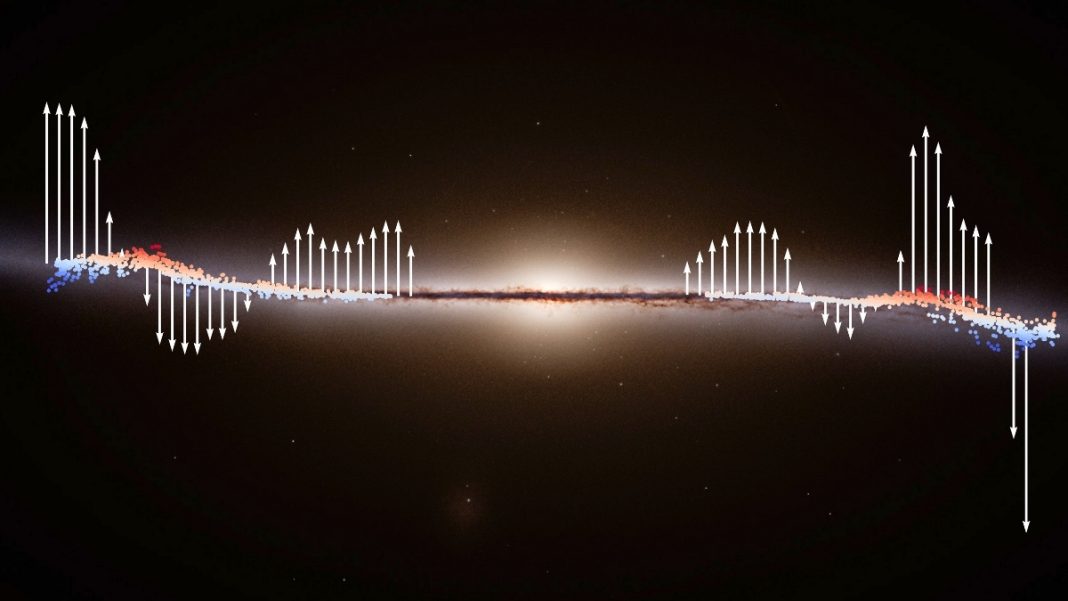Ever feel like you’re just floating through space, minding your own business, in a calm, predictable universe? Well, think again! Our very own Milky Way galaxy, the sprawling cosmic island we call home, is far from static. In fact, it turns out our galaxy recently experienced, or is still experiencing, a massive ripple – a colossal wave of stars – and the European Space Agency’s incredible Gaia mission has captured it in stunning detail.
The Cosmic Ripple: What is This Galactic Wave?
Forget ocean waves or even the sound waves you hear; this isn’t a physical crash of water or air. Instead, imagine a giant, invisible hand has gently, yet powerfully, disturbed the fabric of our galaxy. What Gaia has detected is a peculiar, swirling pattern in the motion and distribution of billions of stars, primarily in the outer disk of the Milky Way. It’s like dropping a massive pebble into a cosmic pond, and watching the ripples spread outwards.
Scientists refer to this as a “phase-space spiral.” Don’t let the jargon scare you! Essentially, it means that when you plot the positions and velocities of stars, they aren’t randomly scattered. Instead, they form a distinct spiral pattern, hinting at a coordinated, undulating motion. It’s a testament to the fact that our galaxy is a dynamic, living entity, constantly in motion and reacting to cosmic events.
Gaia’s Incredible Eye on the Universe
How do we even see such a subtle, yet monumental, galactic event? Enter Gaia. This magnificent space observatory is basically the ultimate cosmic cartographer. It’s painstakingly mapping the precise positions, distances, and movements of over a billion stars in our galaxy, creating the most detailed 3D map of the Milky Way ever conceived. Think of it as a super-accurate GPS for stars.
By observing these stars repeatedly over several years, Gaia can track their tiny shifts and velocities. It’s this meticulous data that revealed the wave. It wasn’t immediately obvious, but when astronomers analyzed the vast dataset, this coherent, undulating motion across a huge swathe of stars became undeniable. “This isn’t just a quirky observation; it’s a profound insight into the gravitational dance occurring right here in our cosmic backyard,” remarked Dr. Elara Vance, a theoretical astrophysicist, highlighting the mission’s groundbreaking contribution.
What This Means for Our Galactic Home
So, what’s causing this titanic ripple? The leading theory points to a close encounter with a smaller galaxy – perhaps the Sagittarius dwarf galaxy, which is known to be slowly orbiting and interacting with the Milky Way. As Sagittarius passes through or near our galaxy, its gravitational pull acts like that massive pebble, sending shivers through the Milky Way’s stellar disk. This isn’t a one-time event; these galactic interactions are thought to be quite common over billions of years, but Gaia has given us an unprecedented, up-close view of the aftermath.
This discovery reinforces the idea that our galaxy is not a serene, isolated system. It’s a bustling metropolis, constantly influenced by its neighbors, sculpted by gravitational forces, and forever evolving. It also offers astronomers a unique opportunity to study the dynamics of galactic mergers and the distribution of dark matter, the mysterious substance that makes up most of the universe’s mass and plays a crucial role in shaping galaxies.
The universe, it seems, is always full of surprises. Thanks to Gaia, we’re not just observing the stars; we’re witnessing the breathtaking, dynamic life of our own cosmic home. It makes you wonder what other galactic secrets are waiting to be unveiled!




